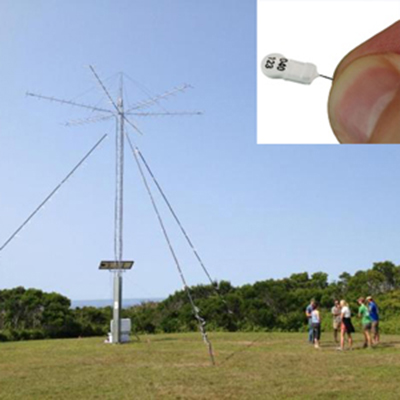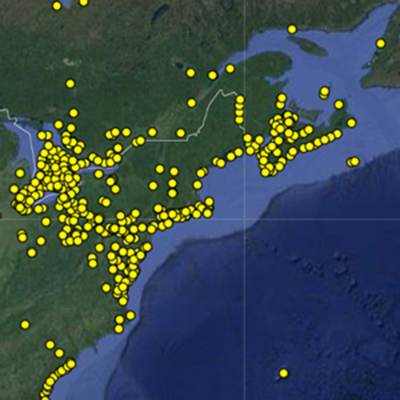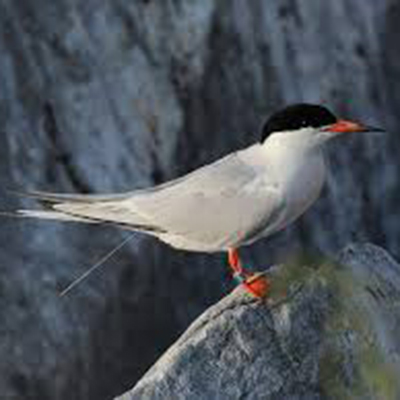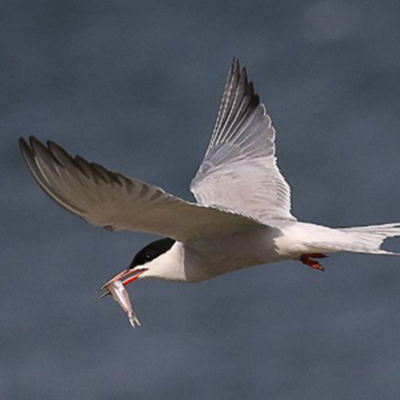Developing Plans to Track Animals Offshore
Biologists from the U.S. Fish and Wildlife Service, BRI, the University of Rhode Island, and Birds Canada have developed guidance for how to integrate automated radio telemetry into pre- and post-construction monitoring plans for offshore wind farms. This technology is used to track animal movements, particularly for small-bodied bird and bat species that cannot handle heavier satellite or GPS transmitters.
USFWS Lead Investigators: Pam Loring, Scott Johnston
URI Lead Investigator: Peter Paton
Contributing URI Staff: Erik Carlson, Doug Gobeille, Rob Deluca
Bird Studies Canada Lead Investigator: Stuart Mackenzie
BRI Lead Investigators: Kate Williams, Evan Adams, Andrew Gilbert
Contributing BRI Staff: Iain Stenhouse, Julia Gulka, Ed Jenkins
How Automated Telemetry Works

Scientists have been using traditional radio telemetry to track animals for decades. Radio transmitters are deployed on animals, and transmit radio signals to a receiver; these signals provide information on where the animal is located relative to the receiver. Radio transmitters provide less precise location information than satellite or GPS transmitters, but can also be much smaller, and so can be deployed on smaller-bodied animals.
Unlike traditional radio transmitters, which send signals at different frequencies, new coded radio transmitters (brand names are “nanotags” and “lifetags”) emit signals at the same frequency, but each transmitter’s signal is uniquely identifiable. This allows receiver units to be automated and record transmissions from large numbers of transmitters. These new transmitters can weigh less than a gram (or about 20% of the weight of a penny), so they can be safely deployed on a wide range of species.

The Motus Wildlife Tracking System is an international network for automated radio telemetry that allows researchers to detect each other’s transmitters and share information across projects, thus greatly increasing the geographic scope of monitoring.
Why Use it for Offshore Wind Development?

We have limited information on the offshore movements of small shorebirds, songbirds, and migratory tree bats. This makes it difficult to predict risk to these species from planned offshore wind energy development. Automated radio tracking could be used for this purpose, but there are few platforms offshore on which to place receivers (see locations of current receivers in the eastern U.S., left).
Putting receivers on offshore wind turbines, site assessment buoys, or other offshore platforms allows us to gather new information on the movements of these animals in the marine environment, including their movements relative to offshore wind farms. Building a network of offshore receivers will take time, but a key first step the development of protocols to help offshore wind developers and regulators integrate this technology into monitoring plans.
Project Goals

Study collaborators developed monitoring protocols for use of automated radio tracking systems at offshore wind farms. This work was conducted via a collaboration with the U.S. Fish and Wildlife Service, Biodiversity Research Institute, University of Rhode Island, and Bird Studies Canada, and was coordinated with a broad group of expert stakeholders. Project components included:
- Protocols to deploy radio transmitters and receivers to help assess risk and understand the impact of offshore wind energy development on birds and bats
- Modeling of animal movements offshore relative to receiver detection ranges, to understand the probability of transmitters being detected as animals fly by a network of receivers
- A free online study design tool to help offshore wind energy developers and regulators determine how many receivers they need to monitor a given offshore wind project, and where those receivers should be placed
- Framework for coordinating offshore monitoring with the Motus Wildlife Tracking System
This project helped make automated radio telemetry a consistent component of monitoring plans for offshore wind farms, and as a result, has greatly improved our understanding of the offshore movements and habitat use of many bird and bat species in the eastern U.S.
Project Activities

Further discussions to help coordinate Motus efforts in relation to offshore wind energy development may occur via the bird and bat subcommittee of the Regional Wildlife Science Collaborative. Please reach out to Pam Loring or Kate Williams for more information.
Stakeholder Workshop: Operating and Calibrating Offshore Motus Stations (July 26, 2022). In conjunction with the State of the Science Workshop on Wildlife and Offshore Wind Energy, Pam Loring (Division of Migratory Birds, U.S. Fish & Wildlife Service) and Erik Carlson (Department of Physics, University of Rhode Island) will provide hands-on demonstrations and discussions on some of the key technical aspects of operating, maintaining, and calibrating automated radio telemetry stations on offshore buoys and wind turbines in coordination with the Motus Wildlife Tracking System. State of the Science Workshop registration is required to attend.
Symposium: Collaborative animal movement studies to improve conservation outcomes (State of the Science Workshop on Wildlife and Offshore Wind Energy, July 27-28, 2022)
Stakeholder Workshop on Offshore Motus Monitoring Framework (Jun. 2022) Agenda | Presentation |
Conference Presentation: Integrating Motus Tracking into Aerofauna Monitoring at Offshore Wind Projects (Conference on Wind Energy and Wildlife Impacts, Apr. 2022). Presentation
Stakeholder Workshop on Offshore Motus Data Framework (Nov. 2021) Agenda | Presentation |Recording| Meeting Summary
Stakeholder Workshop on Guidance for Deploying Automated Radio Telemetry Stations on Offshore Wind Turbines and Buoys (Jan. 2021). Agenda | Presentation | Meeting Summary
Stakeholder Workshop to Discuss Development of an Online Study Design Tool for Offshore Automated Radio Telemetry (Jan. 2021). Agenda | Presentation | Meeting Summary
Conference Presentation: Understanding the Effects of Offshore Wind Energy Development in the U.S. on Birds and Bats: Identifying Key Research Needs, Mitigation Measures, and Conservation Guidance (Wind Wildlife Research Meeting, Dec. 2020). Presentation
Conference Presentation: Regional Collaboration to Identify Research Needs and Develop Conservation Guidance for Offshore Wind Development (North American Ornithological Conference, Aug. 2020). Poster
Introductory Project Webinar for the Project Advisory Committee (Aug. 2020). Presentation
Study Products

Guidance Document: The Guidance Document describes technical specifications for deploying and operating Motus stations on offshore structures to obtain site-specific data on the movements of tagged animals (birds, bats, and insects) through offshore wind project areas.
Study Design Tool and Simulation Study: A free online tool, “Informing the Design and Implementation of Offshore Motus Systems (IDIOMS),” is available to help users optimize site-specific Motus study designs at offshore wind energy facilities. This includes identification of the number and locations of receiving stations necessary to cover a given offshore wind energy project area, relative to factors such as the project size and configuration, key species, question of interest, and specific Motus technology used.
Results from the tool are summarized in automated reports that contain key information on study design that offshore Motus monitoring studies should include as standardized elements in post-construction monitoring plans.
Data Framework: The Offshore Motus Data Framework describes workflows within Motus to coordinate, archive, and serve tag detection data, station data, standardized metadata, and summary reports. The Framework established an Atlantic Offshore Wind Group within the Motus Wildlife Tracking System’s online database to coordinate information among projects collecting data for offshore wind applications in the Atlantic region of North America.
Monitoring Framework: The Monitoring Framework provides a comprehensive overview of using Motus to track birds and bats offshore and to inform research, monitoring, and assessments of offshore wind energy projects in the Atlantic region of North America.
View all study products here.
Project Funding & Timeline

Funding to for this project came from the New York State Energy Research and Development Authority (NYSERDA), with additional support from the U.S. Fish and Wildlife Service Migratory Bird Program. The project was initiated in spring of 2020 and was completed in early 2023.


